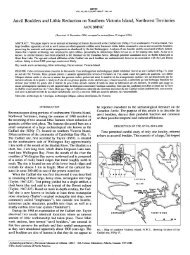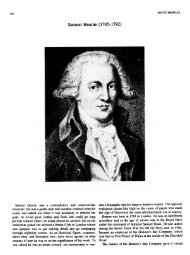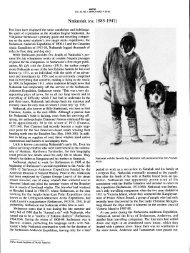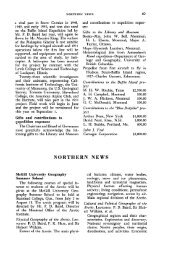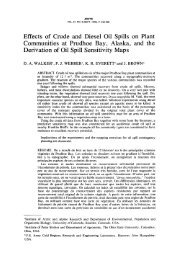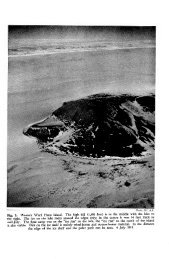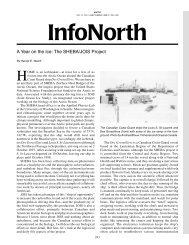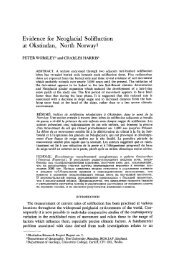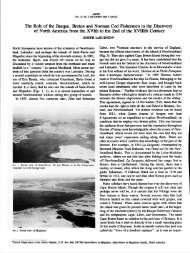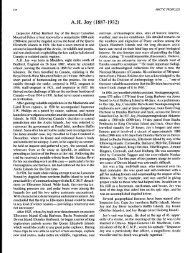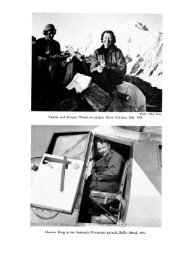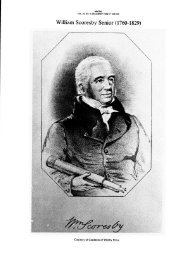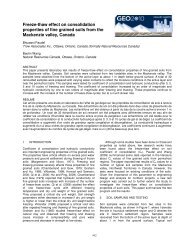NOTES ON THE NUNAMIUT ESKIMO AND MAMMALS OF ... - arctic
NOTES ON THE NUNAMIUT ESKIMO AND MAMMALS OF ... - arctic
NOTES ON THE NUNAMIUT ESKIMO AND MAMMALS OF ... - arctic
You also want an ePaper? Increase the reach of your titles
YUMPU automatically turns print PDFs into web optimized ePapers that Google loves.
176 <strong>THE</strong> <strong>NUNAMIUT</strong> <strong>ESKIMO</strong> <strong>AND</strong> <strong>MAMMALS</strong> <strong>OF</strong> <strong>THE</strong> ANAKTUVUK PASS REGI<strong>ON</strong><br />
reported by the Nunamiut. I saw tracks in the upper Savioyok valley in the<br />
fall of 1950, and it is possible that mink are permanent residents in this valley<br />
as the creeks are kept open all winter by flowing springs. The invertebrate<br />
fauna of these creeks is abundant, and a small <strong>arctic</strong> char, Salvelinus alpinus<br />
(L.), is common. No specimen of mink has been obtained.<br />
Gulo luscus luscus (Linnaeus) . Icavik. Wolverine.<br />
The wolverine is widely distributed in this region. Eight skulls have<br />
been obtained; their measurements are given in Table 111.<br />
Sex Condylobasal<br />
length<br />
Zygomatic<br />
width<br />
Squamosal<br />
constriction<br />
Coronoid<br />
height<br />
Maxillary<br />
tooth row Interorbital<br />
length width<br />
d<br />
d<br />
8<br />
d<br />
140.7<br />
141.6<br />
143.7<br />
144.5<br />
101<br />
101.2 77<br />
78<br />
105.1<br />
103.4<br />
50.5<br />
48.7<br />
50.5 80.6<br />
80.7<br />
51.3<br />
51.9 38.6<br />
52<br />
51.2<br />
38.6<br />
43.4<br />
d<br />
7 d<br />
145.5<br />
146<br />
147.5<br />
155.5<br />
104<br />
106<br />
111<br />
76<br />
77.5<br />
107.5<br />
86<br />
50 76.1<br />
53.5<br />
51.5 42.6<br />
54 52 39<br />
52.5 41 54<br />
54.9 42.5<br />
57 41<br />
Table 111. Skull measurements from 8 wolverine collected in the Anaktuvuk Pass region<br />
(in millimetres).<br />
Degerbgl and Freuchen (1935) were of the opinion that the North<br />
American and European wolverines belong to the same species. This<br />
conclusion does not appear to have had the support of American mammalogists.<br />
However, in view of the ever-increasing number of species now recognized to<br />
have a circumpolar distribution, it would seem that the wolverine will likewise<br />
have to be considered a circumpolar species. I have not compared the<br />
skulls of Brooks Range wolverines with those from Eurasian animals.<br />
A large male wolverine, trapped 20 October 1950 at the mouth of Anaktiktoak<br />
Creek, measured 925 mm. in total length and weighed 34 pounds. The<br />
Nunamiut remarked that they had never seen any larger than this.<br />
The Eskimo maintain that the male animals are most often dark-coloured,<br />
while the females show prominent lateral streaks. On the basis of a relatively<br />
small number of skins examined, this appears to be the case. There is much<br />
colour variation; the lateral streaks vary from nearly white to rufous or brown,<br />
and in some males are hardly visible.<br />
The food of the wolverine consists mainly of snowshoe hares, a good<br />
proportion of mice, and occasional wolf-kills and other carcasses. Under<br />
favourable conditions a few sheep are killed, or, rarely, a caribou.<br />
From 3 to 6 wolverine are trapped each year by the Nunamiut, who use<br />
the fur for parka trimming. In some years as many as 12 to 15 are killed.<br />
I have not heard of any case of wolverine robbing caches in this country; this<br />
is probably because of their general scarcity. The Nunamiut ordinarily trap<br />
wolverine in rock deadfalls. These are set in the fall, using as bait the nose<br />
or foot of caribou, which cannot readily be destroyed by voles. The site is<br />
selected with considerable care, so that the deadfall will not be covered by<br />
snow. Many such traps can be set, and it is not necessary to check them until



